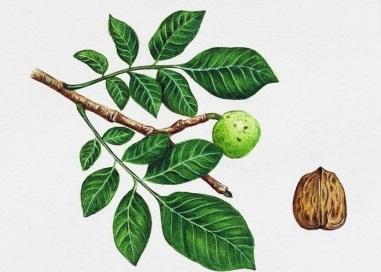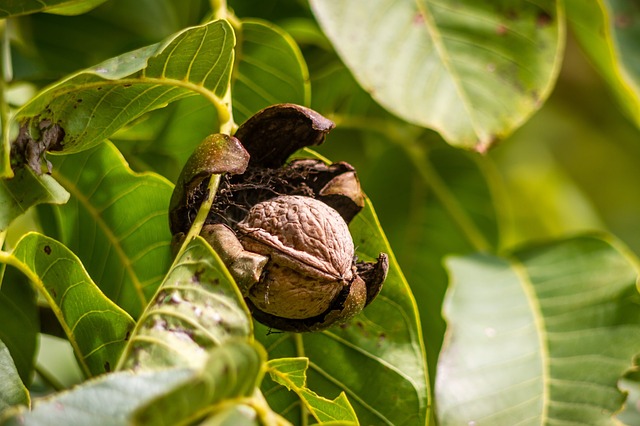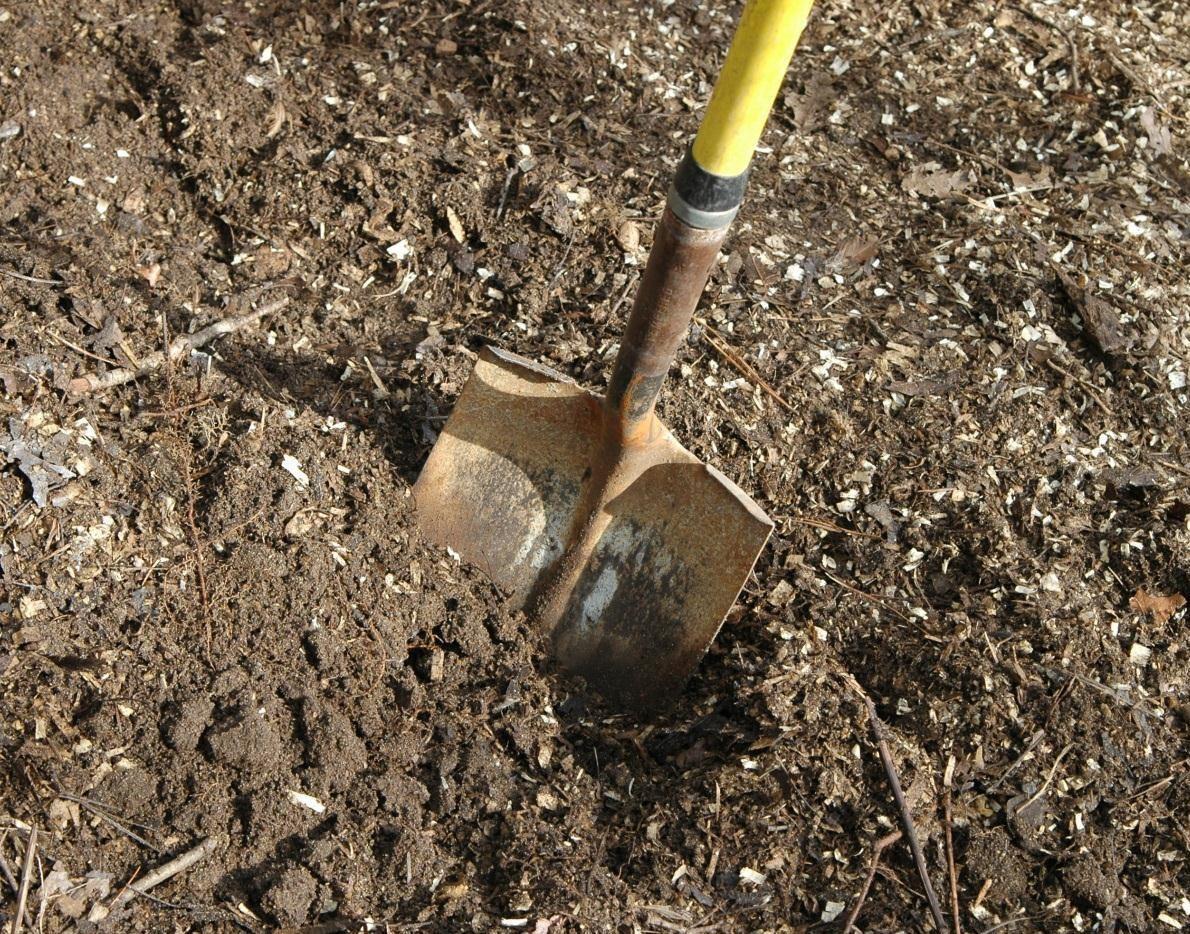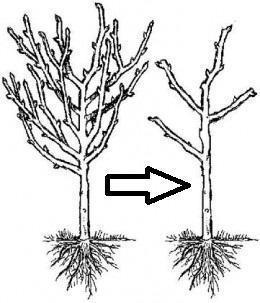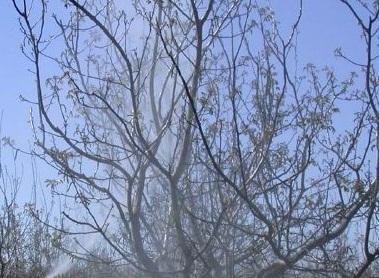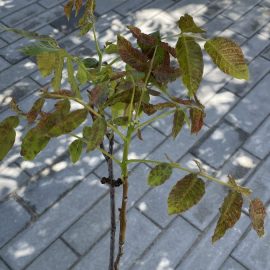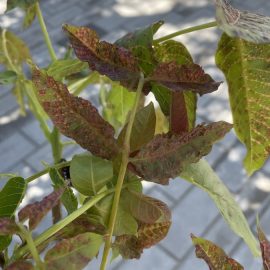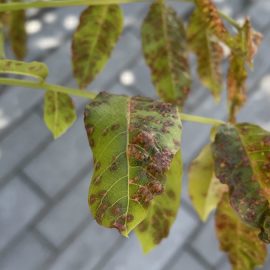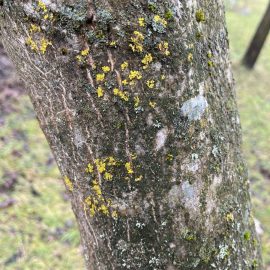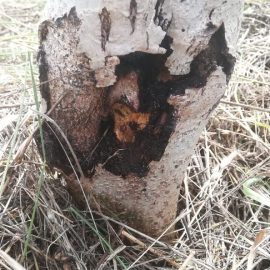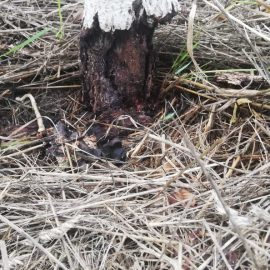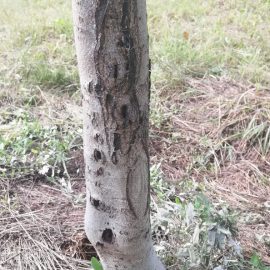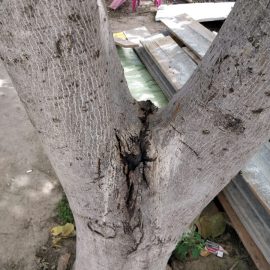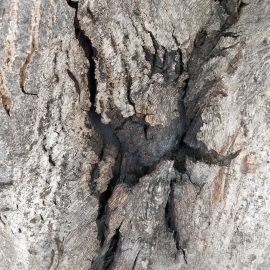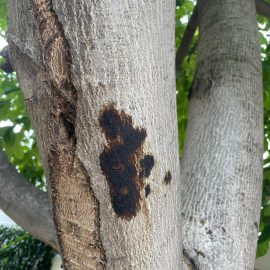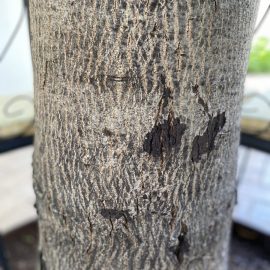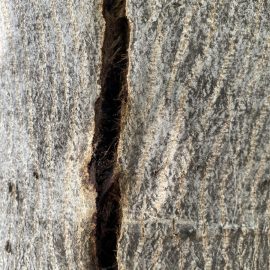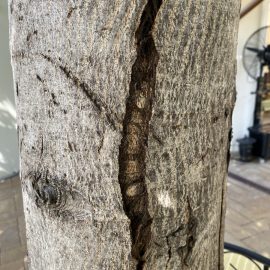Walnut tree, planting, growing and harvesting
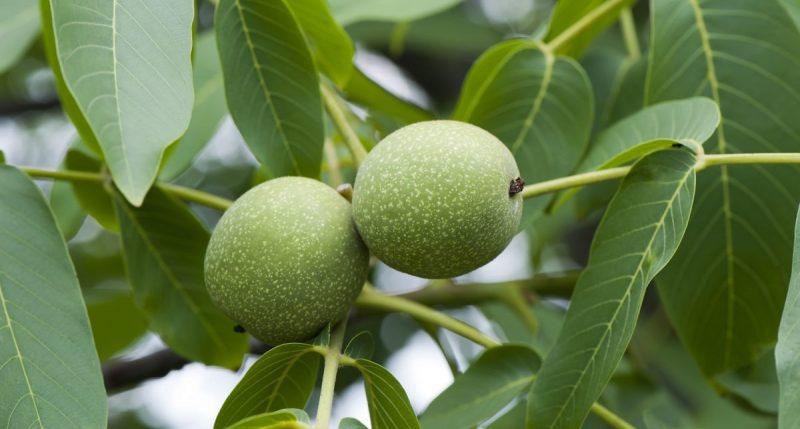
Walnut tree (Juglans regia) It is a large tree, considered one of the most important cultivated fruit trees, due to its various uses (in the food industry, the wood industry, but also as a decorative plant). The trunk is strong, the bark is smooth and gray, and forms a branched crown with strong branches. The leaves are large, and elliptical with a full edge, and the fruit is a spherical drupe, rich in oils, popularly called walnut. Walnuts contain large amounts of calcium and magnesium. In addition to these substances, nuts also contain fats, protein substances, carbohydrates, minerals, and vitamins (A, B, C, P).
Growing and fruiting particularities
The root system develops depending on the soil properties, but in general, the mass of roots is located at a depth of 20-60 cm. Root growth is continuous but with different intensities depending on the growing season. The aerial part develops slowly in the first 2-3 years after planting.
After the first years, the growth intensifies and the trees reach heights of 20 meters.
The walnut emerges from dormancy after average temperatures reach 9°C. It forms two types of flowers: female and male, which may bloom simultaneously or at different intervals. For good fruiting, you can plant 3-4 different varieties in the orchard, which flower at the same time. They bear fruit 5-8 years after planting and reach their maximum yields 10 years after planting. The tree produces fruit for a period of 30 to 100 years, making it one of the longest-lived of all fruit species.
Climate and soil requirements
The Walnut tree is a heat-loving species. During the dormant period, mature trees withstand temperatures of -20 ° C, while flowers and twigs are affected by temperatures below -2 ° C. Excessive summer temperatures are harmful to walnuts, so to avoid scorching, walnut trees should be planted on north-facing slopes. It grows well in areas where 600-700 mm of rainfall falls annually.
In the absence of water, the trees have small growths, form a small number of buds, and production is poor. It is sensitive to stagnant water in the soil. The walnut tree uses all types of soil, but the highest yields are obtained on the permeable, fertile ones with a light texture. Under irrigation conditions, it can be planted on sandy soils.
Cultivation
Soil preparation
The land where the walnut orchard will be established must be protected from late spring and autumn frosts. Soil preparation work is similar to that for other species. If the plantation is established on land that has been used as an orchard, the soil must be prepared 3-4 years in advance. To restore the soil structure, it can be cultivated with perennial grasses, legumes, or cereals. If the plot is heavily infested with weeds or has been grown with perennial grasses, you can apply herbicides.
Recommended products
-
You can find products on a different store
Change Store -
You can find products on a different store
Change Store -
You can find products on a different store
Change Store -
You can find products on a different store
Change Store -
You can find products on a different store
Change Store -
You can find products on a different store
Change Store -
You can find products on a different store
Change Store -
You can find products on a different store
Change Store -
You can find products on a different store
Change Store -
You can find products on a different store
Change Store -
You can find products on a different store
Change Store -
You can find products on a different store
Change Store -
You can find products on a different store
Change Store -
You can find products on a different store
Change Store -
You can find products on a different store
Change Store -
You can find products on a different store
Change Store -
You can find products on a different store
Change Store -
You can find products on a different store
Change Store -
You can find products on a different store
Change Store -
You can find products on a different store
Change Store -
You can find products on a different store
Change Store -
You can find products on a different store
Change Store -
You can find products on a different store
Change Store -
You can find products on a different store
Change Store
It is recommended to scarify the soil so that the roots grow easily. All foreign matter in the soil must be collected and removed from the plot, after which the land must be well-leveled. For precise planting, the land can be picketed. The operation represents marking the tree’s position.
Planting
The walnut tree is sensitive to transplanting, therefore, it is recommended to use 2-3-year-old saplings (they can withstand transplanting best). The best time for planting is autumn because during this period the saplings are dormant and adapt easily to the orchard conditions.
By the following spring, the wounds on the roots will heal and the tree will start growing well. In small areas, walnut trees can be planted early in spring. The saplings should only be obtained from authorized nurseries or orchards. The following planting scheme is recommended: 10 meters between rows and 8 meters between trees per row.
Root trimming
Before planting, the roots should be trimmed. The purpose of this procedure is to remove the damaged portions and maintain a healthy root system. The necrotic roots must be removed completely and the healthy ones, shortened by 7-8 cm.
After trimming, the roots can be soaked. Mudding is placing the roots in a mixture of yellow soil, fresh manure, and water. The role of the mud layer is to ensure a higher humidity around the root system. The mud must have the consistency of sour cream. If the saplings have been transported long distances, before soaking, they must be placed in a bowl of water for 2 hours. This operation aims to rehydrate the roots.
Actual planting
This stage begins by digging the pit. If the land has not been worked, the pit should be dug 2-3 months before and as large as possible. The following dimensions are recommended: 100 x 100 x 80 cm. If the land has been worked properly, the pit should be dug 1-2 days before or even on the same day (so as not to lose water from the soil). In this case, the pit will have the following dimensions: 60 x 60 x 60 cm.
At the base of the pit, you can introduce a mixture of fertile soil removed from the topside of the pit and well-decomposed manure. Insert the sapling into the pit so that the root stays on the fertile layer at the base. When planting, the roots must be in close contact with the soil. The planting depth is calculated so that the grafting point is 3-4 cm above the ground and facing north. After planting, place a stake next to the sapling and water the soil thoroughly.
Add a layer of mulch around the tree. Mulching maintains a good phytosanitary condition, prevents weed growth, conserves water in the soil, and reduces the number of maintenance works. The sapling can be covered with rodent protection materials or the orchard can be fenced.
Care works
In spring, the soil needs to be dug and kept clean and the mulch around the trees, refreshed. However, the most important maintenance work is pruning. Their role is to form the tree crown and to maintain a balance between vegetative growth and fruiting.
Recommended products
-
You can find products on a different store
Change Store -
You can find products on a different store
Change Store -
You can find products on a different store
Change Store -
You can find products on a different store
Change Store -
You can find products on a different store
Change Store -
You can find products on a different store
Change Store -
You can find products on a different store
Change Store -
You can find products on a different store
Change Store -
You can find products on a different store
Change Store -
You can find products on a different store
Change Store -
You can find products on a different store
Change Store -
You can find products on a different store
Change Store -
You can find products on a different store
Change Store -
You can find products on a different store
Change Store -
You can find products on a different store
Change Store -
You can find products on a different store
Change Store -
You can find products on a different store
Change Store -
You can find products on a different store
Change Store -
You can find products on a different store
Change Store -
You can find products on a different store
Change Store -
You can find products on a different store
Change Store -
You can find products on a different store
Change Store -
You can find products on a different store
Change Store -
You can find products on a different store
Change Store
Walnut tree pruning is done during the growing season (summer). It is not recommended to prune during the dormant period, because the tree heals very slowly. In the first spring after planting, the tree must be shortened to a height of 70 cm. During the summer, pinch the top of the twigs (cut a small part of the top). Do not apply any other pruning in the first year.
In the spring of the second year, remove all the twigs. Leave only the main shaft extension twig. From the main stem, other twigs will start. In summer, the tips of these twigs should be pinched off (a small part of the tip is cut off).
In the third year, spring, the tree can reach a height of 180-200 cm. It can be shortened to 150 cm tall. In the summer, remove all twigs up to a height of 100 cm. On the upper portion (100-150 cm), leave 3-4 twigs evenly placed on the main axis.
Maintenance pruning
After the tree bears fruit, apply maintenance pruning. Remove competing branches, water sprouts, overgrown branches, and branches that overlap and prevent light penetration. Aged branches are cut back to stimulate the emergence of new fruiting branches. In the case of old trees at the end of their fruiting period, pruning should be severe. Shorten 5-6 year old branches, whereby the size of the crown is reduced by 30%. Wounds larger than 4-5 cm are covered with tree wound sealer.
Recommended products
-
You can find products on a different store
Change Store -
You can find products on a different store
Change Store -
You can find products on a different store
Change Store -
You can find products on a different store
Change Store -
You can find products on a different store
Change Store -
You can find products on a different store
Change Store -
You can find products on a different store
Change Store -
You can find products on a different store
Change Store -
You can find products on a different store
Change Store -
You can find products on a different store
Change Store -
You can find products on a different store
Change Store -
You can find products on a different store
Change Store -
You can find products on a different store
Change Store -
You can find products on a different store
Change Store -
You can find products on a different store
Change Store -
You can find products on a different store
Change Store -
You can find products on a different store
Change Store -
You can find products on a different store
Change Store -
You can find products on a different store
Change Store -
You can find products on a different store
Change Store -
You can find products on a different store
Change Store -
You can find products on a different store
Change Store -
You can find products on a different store
Change Store -
You can find products on a different store
Change Store
Until it bears fruits, the land in the orchard must be kept free of weeds or cultivated with fodder plants. Cultivated plants should not compete with trees for water and food. When the plantation has reached maturity, the land should be kept tilled or cultivated with plants for green manure (Lolium Perene). The grass must be mowed repeatedly and used as mulch. However, the most practical solution is to apply herbicides (after 3 years from planting).
Fertilization
Fertilization is necessary in young orchards to stimulate vegetative growth. In young plants, apply nitrogen-based fertilizers. After the plants have started fruiting, apply complex fertilizers in three stages (early spring, after fruit formation, and autumn).
Recommended products
-
You can find products on a different store
Change Store -
You can find products on a different store
Change Store -
You can find products on a different store
Change Store -
You can find products on a different store
Change Store -
You can find products on a different store
Change Store -
You can find products on a different store
Change Store -
You can find products on a different store
Change Store -
You can find products on a different store
Change Store -
You can find products on a different store
Change Store -
You can find products on a different store
Change Store -
You can find products on a different store
Change Store -
You can find products on a different store
Change Store -
You can find products on a different store
Change Store -
You can find products on a different store
Change Store -
You can find products on a different store
Change Store -
You can find products on a different store
Change Store -
You can find products on a different store
Change Store -
You can find products on a different store
Change Store -
You can find products on a different store
Change Store -
You can find products on a different store
Change Store -
You can find products on a different store
Change Store -
You can find products on a different store
Change Store -
You can find products on a different store
Change Store -
You can find products on a different store
Change Store
Irrigation
Irrigation is essential in areas with rainfall deficits and for young plantations. In the case of young plantings, apply 2-3 irrigations with norms of 300 cubic meters/ha. If the plantation is mature, apply 3 irrigations with norms of 600 cubic meters/ha. Irrigation can be done on furrows or by drip. Avoid sprinkler irrigation to reduce foliar disease.
Pests and disease control
The walnut tree is affected by several diseases, the most damaging of which are bacterial blight and anthracnose. These can compromise the harvest, and in the case of strong attacks can destroy the entire orchard.
Carrying out phytosanitary treatments according to a specific schedule can significantly reduce the occurrence of diseases and pests. To destroy outbreaks in the orchard, apply treatments during the dormant period (winter). Treatments should be applied in autumn-winter when the temperature is above 5° C.
Against diseases, the first treatment (after leaf fall) should be done with copper-based products. The second spraying with copper-based products must be done in spring, at bud break. The solution should be sprayed all over the tree, from the base of the tree to the branches. These treatments need to be applied on days without rainfall, with temperatures above 6-7° C, so the solution does not freeze on the trees.
Recommended products
-
You can find products on a different store
Change Store -
You can find products on a different store
Change Store -
You can find products on a different store
Change Store -
You can find products on a different store
Change Store -
You can find products on a different store
Change Store -
You can find products on a different store
Change Store -
You can find products on a different store
Change Store -
You can find products on a different store
Change Store -
You can find products on a different store
Change Store -
You can find products on a different store
Change Store -
You can find products on a different store
Change Store -
You can find products on a different store
Change Store -
You can find products on a different store
Change Store -
You can find products on a different store
Change Store -
You can find products on a different store
Change Store -
You can find products on a different store
Change Store -
You can find products on a different store
Change Store -
You can find products on a different store
Change Store -
You can find products on a different store
Change Store -
You can find products on a different store
Change Store -
You can find products on a different store
Change Store -
You can find products on a different store
Change Store -
You can find products on a different store
Change Store -
You can find products on a different store
Change Store
7-10 days after applying the copper treatments, apply a horticultural oil treatment, which acts against pests that may overwinter in the bark of the tree.
Recommended products
-
You can find products on a different store
Change Store -
You can find products on a different store
Change Store -
You can find products on a different store
Change Store -
You can find products on a different store
Change Store -
You can find products on a different store
Change Store -
You can find products on a different store
Change Store -
You can find products on a different store
Change Store -
You can find products on a different store
Change Store -
You can find products on a different store
Change Store -
You can find products on a different store
Change Store -
You can find products on a different store
Change Store -
You can find products on a different store
Change Store -
You can find products on a different store
Change Store -
You can find products on a different store
Change Store -
You can find products on a different store
Change Store -
You can find products on a different store
Change Store -
You can find products on a different store
Change Store -
You can find products on a different store
Change Store -
You can find products on a different store
Change Store -
You can find products on a different store
Change Store -
You can find products on a different store
Change Store -
You can find products on a different store
Change Store -
You can find products on a different store
Change Store -
You can find products on a different store
Change Store
Harvesting
Harvesting begins in late fall when the walnuts begin to fall from the tree. The fruits ripen gradually, being necessary to harvest in 2-3 stages. The operation is done by gathering the fallen fruit from the ground. Harvesting can be accelerated by shaking the trees.
If the walnuts have been harvested together with the green husk, they can be easily removed if the fruits are placed in cold water for 2-3 hours. To remove the whole core from the walnut, they can be submerged for an hour in hot water.














































































































































































































































































































































































































































